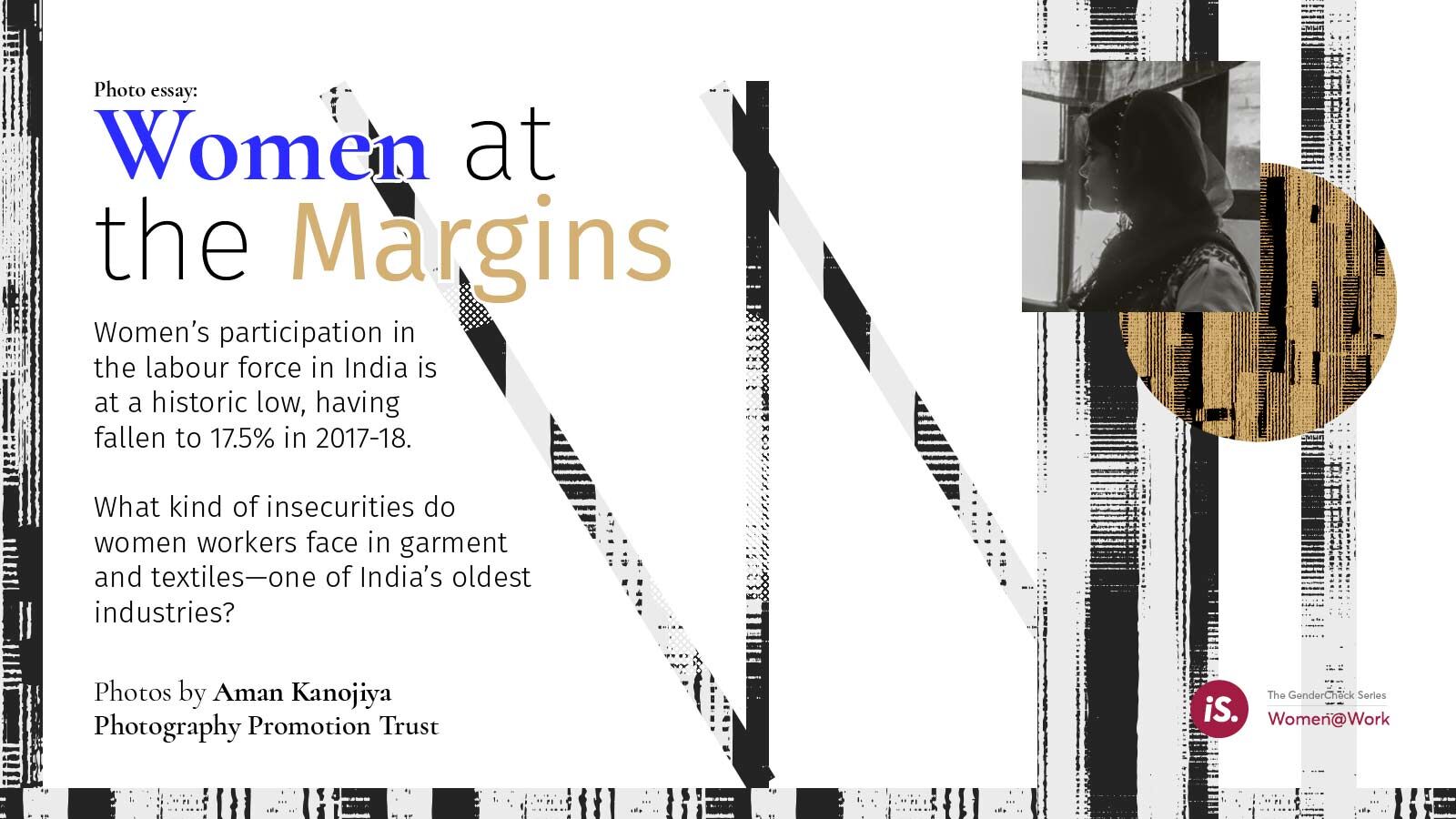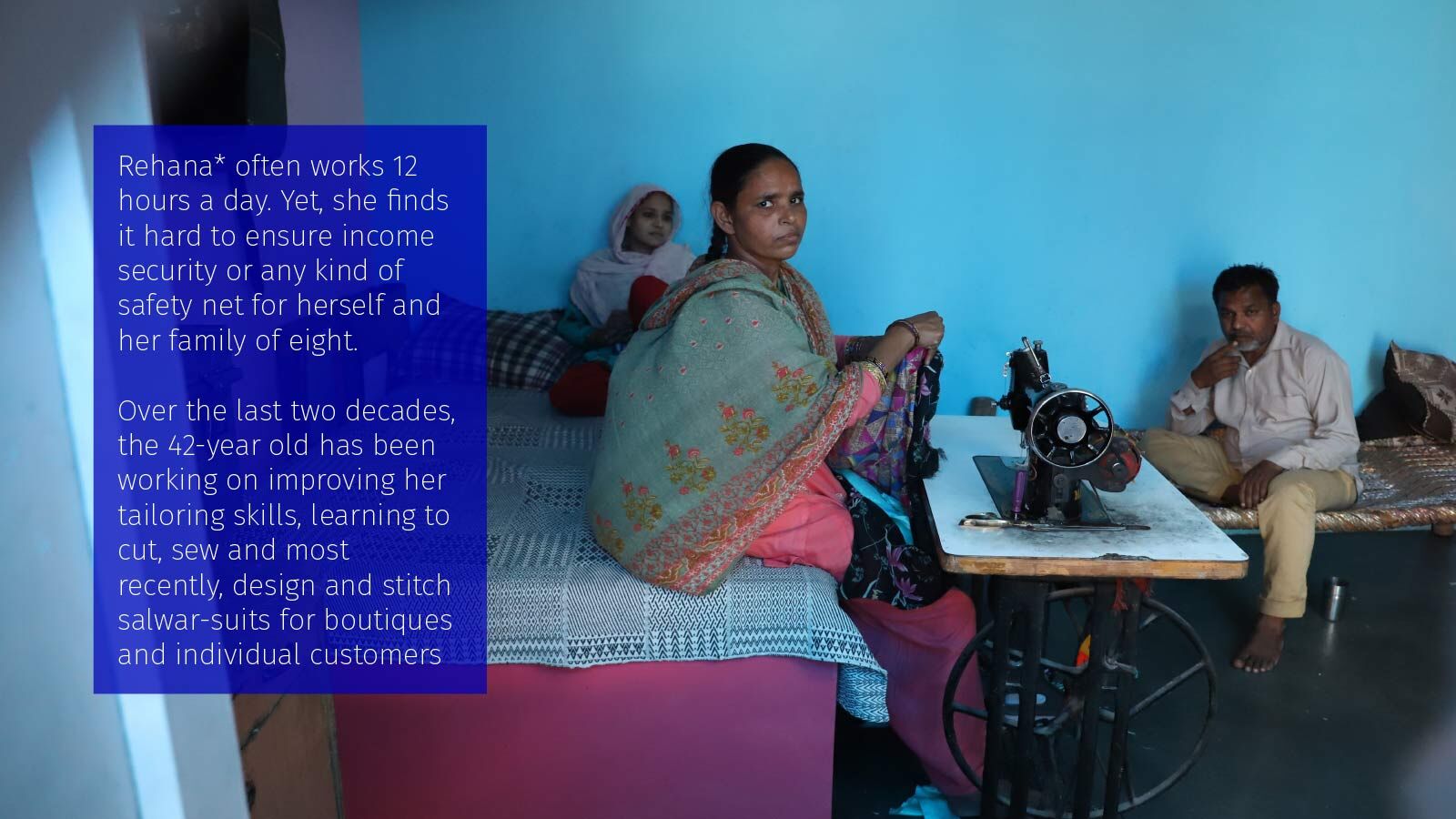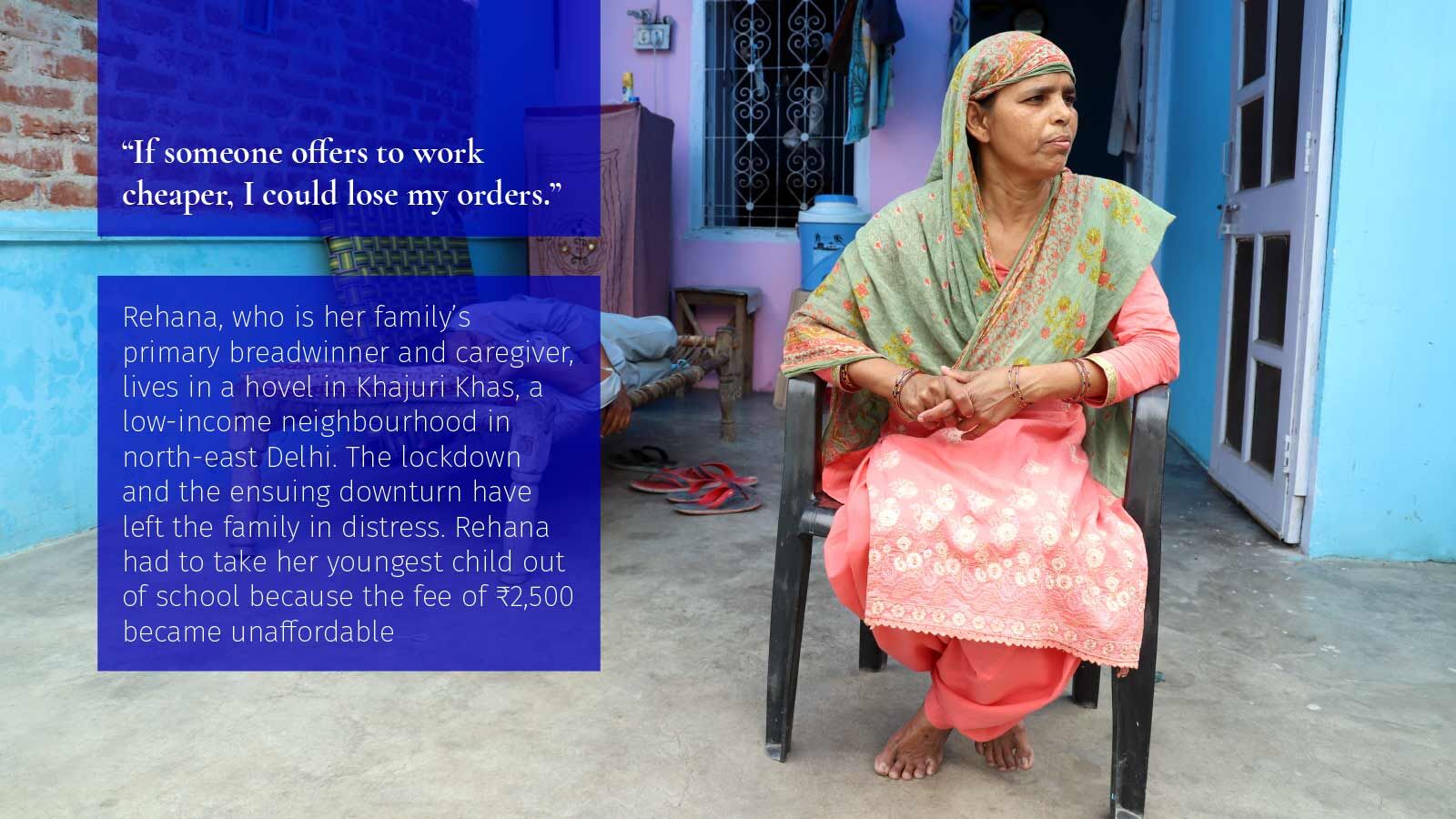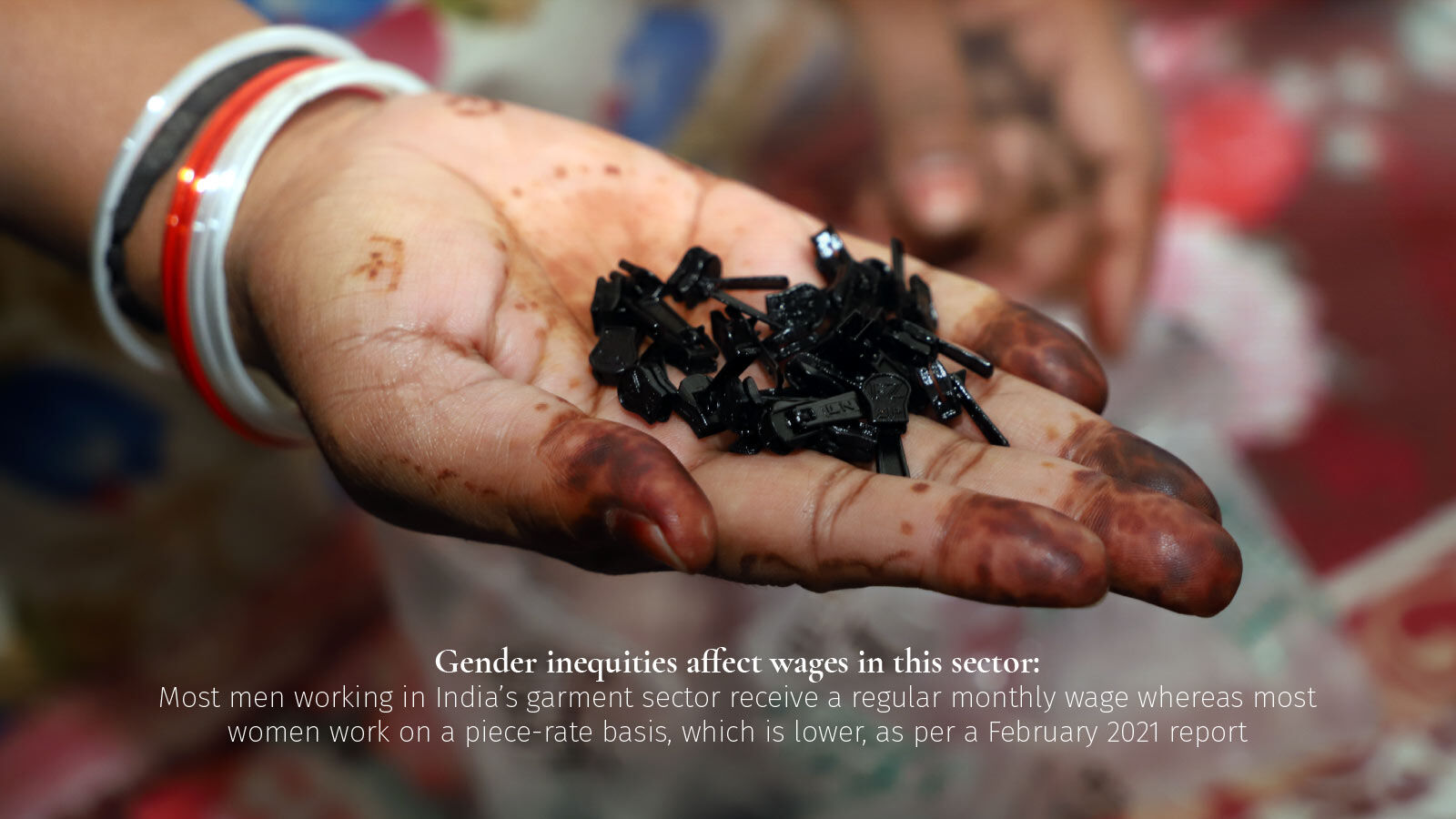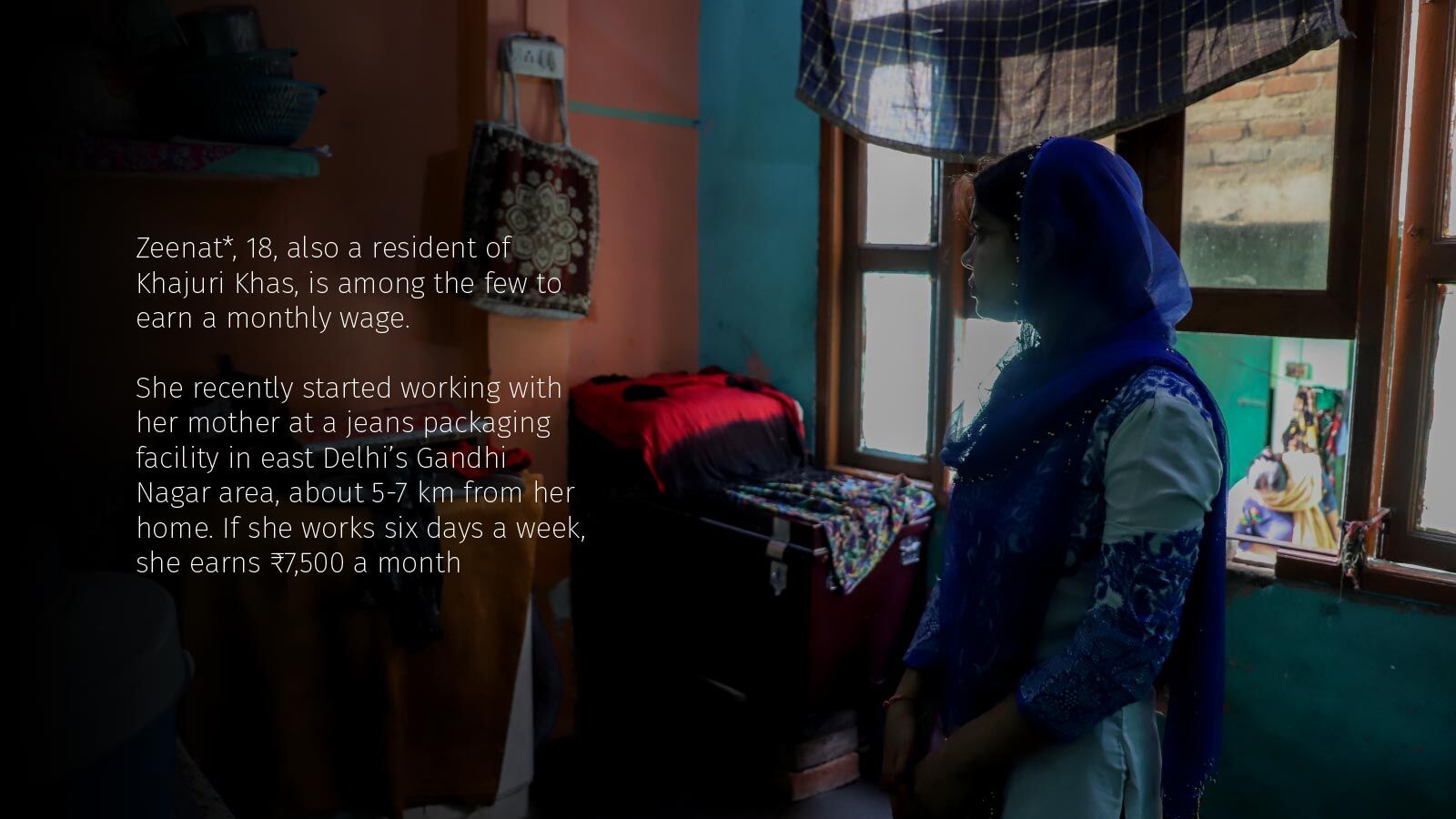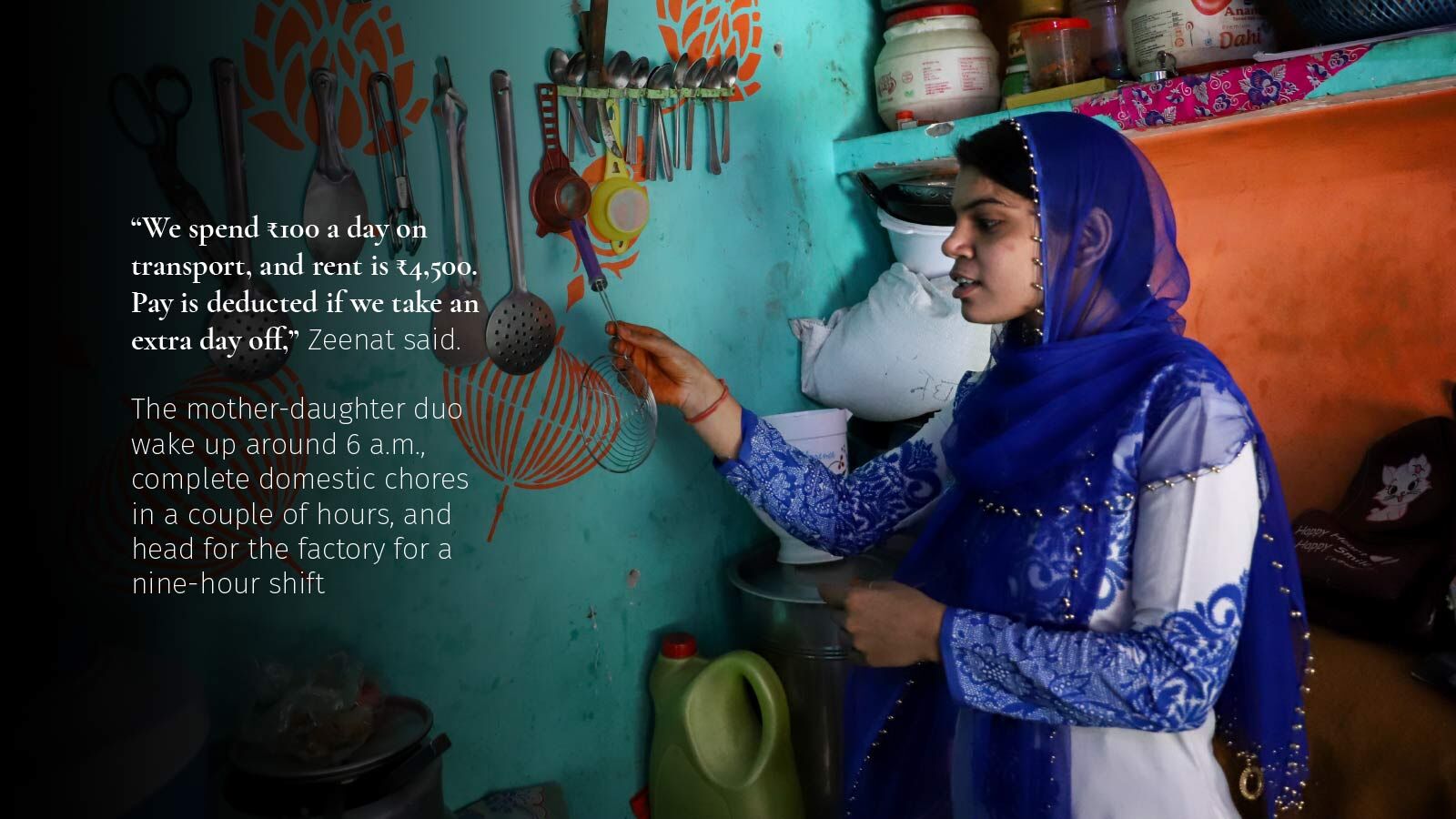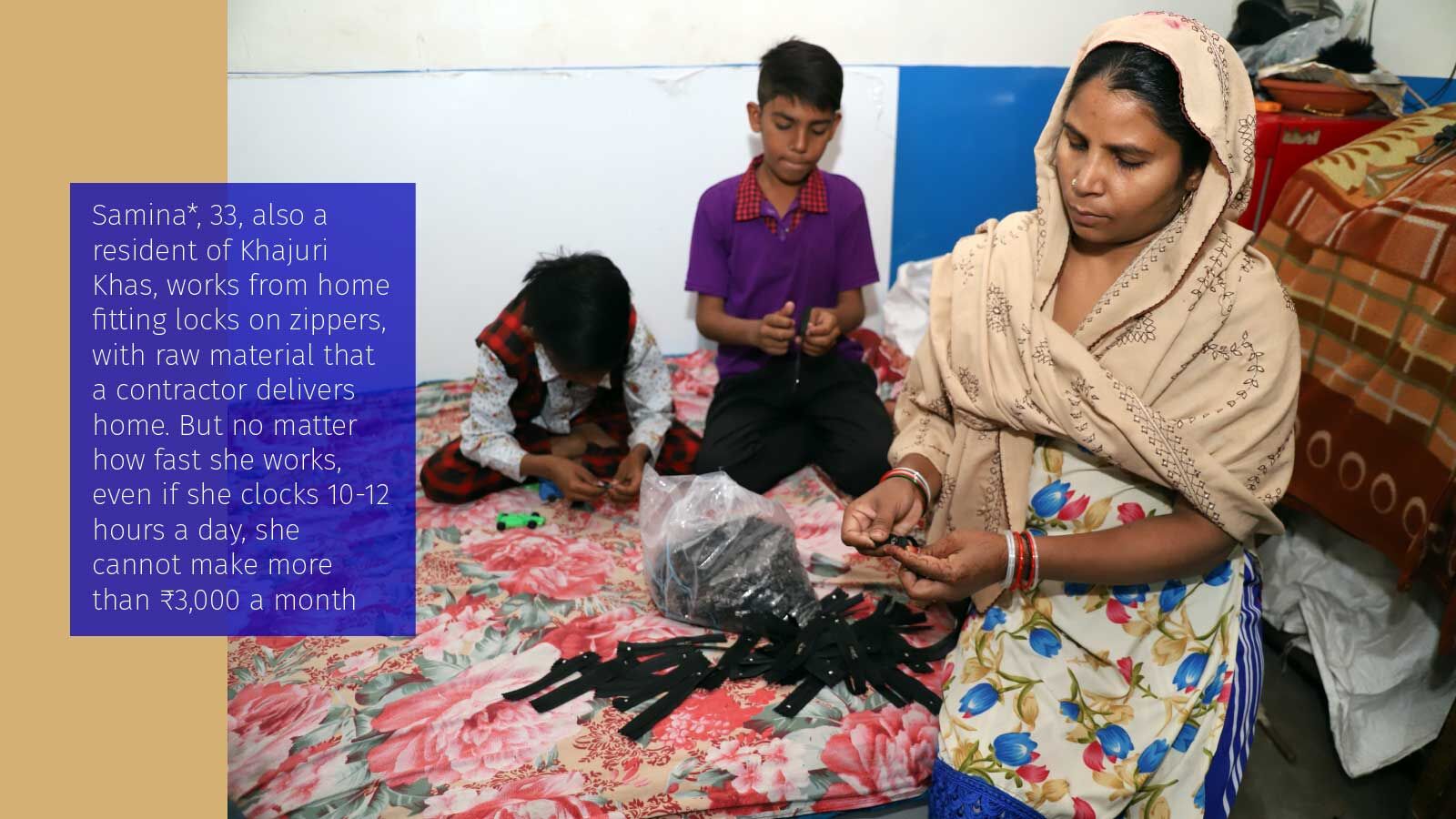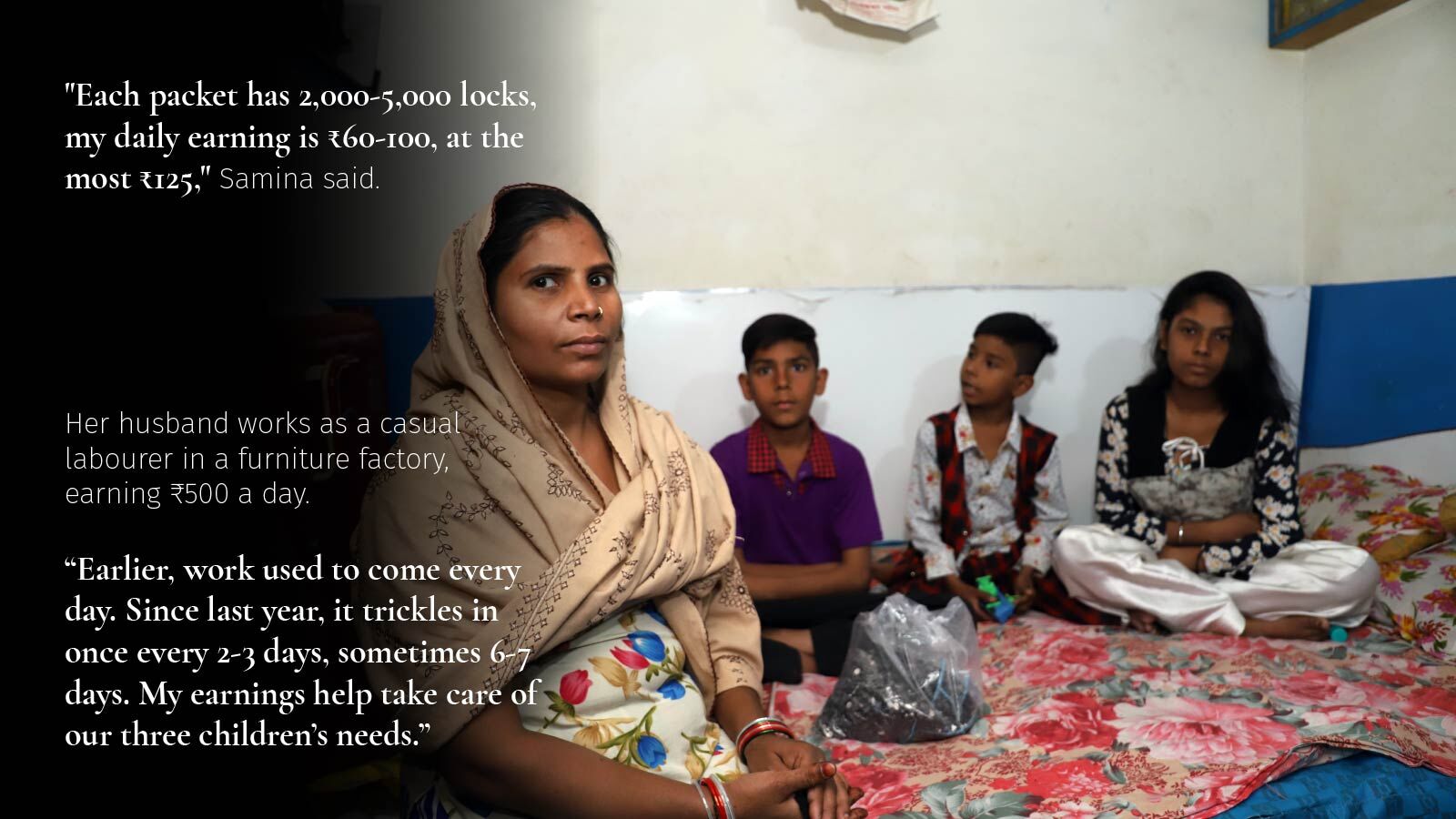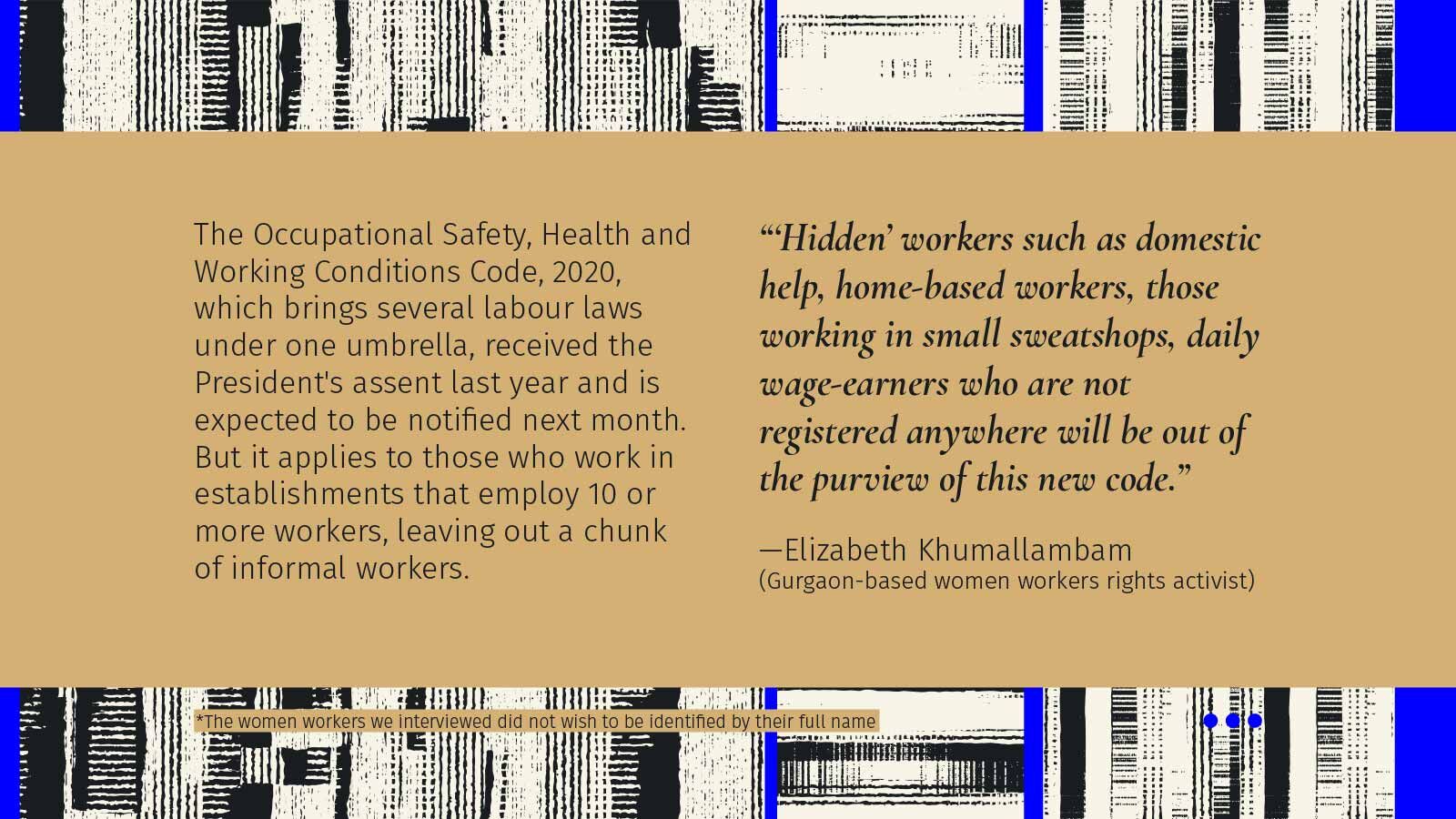'I Can't Earn More Than Rs 125 A Day No Matter How Hard I Work'
India's 96 million informal workers fight gender bias and pay gaps. Our story examines the situation in the textiles and garments sector, among India's oldest, where many women workers put in over 12 hours a day, six days a week, but do not have the negotiating power to demand better wages or working conditions.
New Delhi: Over the last two decades, Rehana*, 42, has been working on improving her tailoring skills, learning to cut, sew, and recently, design and stitch salwar suits for boutiques and individual customers. But even though she often works 12-hour days, she has little income security or any kind of safety net for herself and her family of eight.
Rehana, who is her family's primary breadwinner and caregiver, lives in a hovel in Khajuri Khas, a low-income neighbourhood in north-east Delhi that witnessed riots last year. Many of those who live in the area work in the informal sector, especially garment units, we found. Rehana's husband has partial paralysis, her father-in-law is ageing, and her two sons hold small, casual jobs. The lockdown and the ensuing downturn have left the family in distress and Rehana has had to take her youngest child out of school because the fee, Rs 2,500, has become unaffordable.
Two years ago, Rehana had hoped that investing in two motorised sewing machines would help her step up production, but it also meant that her monthly power bills have gone up to Rs 600-700. Her earnings continue to stagnate at Rs 4,000-5,000 a month. She cannot afford to demand a better price from her clients: "If someone offers to work for less, I could lose my orders."
Rehana's problems echo those faced by many among the 96 million women who work in India's informal economy, according to 'Women in The Informal Economy', a February 2021 report of the Initiative for What Works to Advance Women and Girls in the Economy (IWWAGE), a gender research and advocacy organisation, and the Institute of Social Studies Trust (ISST). India's informal sector, which employs nearly 90% of its labour force, is among the largest globally.
It includes those working in an array of manufacturing and service enterprises, ranging from self-employed waste collectors to stay-at-home garment embroiderers. The same factory could employ formal workers but have informal workers on certain lines--the former would be covered by provident fund, get paid leave and other benefits, while the latter may just receive wages as cash and nothing else.
Women make for only 23% of those employed in India's informal sector, but up to 91% of Indian women in paid jobs are in the informal sector, according to the IWWAGE-ISST report.
Despite their numbers, women working in the informal sector have to also deal with the double whammy of insecurity as well as gender bias--their incomes tend to be low and fluctuating, they do not have the bargaining power to seek better terms or working conditions, and they have low social status, says 'Strengthening Socio-Economic Rights of Women in the Informal Economy', an October 2020 report published jointly by IWWAGE and the Self-Employed Women's Association (SEWA).
At a time when women's participation in the labour force in India is at a historic low, falling to 17.5% in 2017-18, we investigate the disadvantages women face in the informal sector with special emphasis on the textiles and garments sector, one of India's oldest industries.
Working out of compulsion, not choice
Employment in the informal sector and informal employment are two different concepts: The first is defined in terms of the characteristics of the place of work, while the latter is related to the employment relationship and social protection associated with the job, as per the IWWAGE-ISST report.
The garment workers we spoke to fall under either or both of these categories. Zeenat, who we will encounter later in the story, works in a jeans packaging unit. She gets no paid leave, and her employer deducts money from her wages for sick leave. Rehana and Samina, who work from home, have no job security or regular income.
The study also pointed to the fact that women enter this sector out of compulsion, not choice. "In most developing countries, the gender dimension of informality is closely related to poverty, indicating that women informal workers are poorer relative to men informal workers. It also signifies that most people enter informal employment not by choice but due to lack of employment opportunities in the formal economy and in the absence of any other means of earning a living," said the report.
Women also tend to prioritise short-term basic needs, not engaging in long-term financial planning through savings or wealth accumulation. This means that they are often forced to keep their savings at home or avail of credit through informal mechanisms and moneylenders.
India's textiles and garments sector
The Asia and the Pacific region accounts for 60% of the world's total apparel exports. In 2019, the region employed an estimated 65 million garment sector workers or 75% of all garment sector workers worldwide. Most garment workers in the Asia-Pacific region are women (35 million), and the garment sector employs 5.2% of all working women in the region, or 27.9% of all women working in the manufacturing sector, according to 'The Supply Chain Ripple Effect: How COVID-19 is Affecting Garment Workers and Factories in Asia and the Pacific', an International Labour Organization (ILO) research brief October 2020.
India's textiles industry plays a critical role in its economy--it contributes 2% of the GDP and 12% of export earnings. It employs 14.6 million workers, 4.1% of all employed. Among women who are employed, female garment workers make for 6.1%.
There are gender inequities in how wages are structured in this sector: Most men working in India's garment sector receive a regular monthly wage whereas many women, like Rehana, work on a piece-rate basis, which is lower, as per the February 2021 IWWAGE-ISST report.
'I can't earn more than Rs 125 a day no matter how hard I work'
Zeenat*, 18, also a resident of Khajuri Khas, is among the few to earn a monthly amount. She recently started working with her mother, Kishwar*, 36 at a jeans packing facility in east Delhi's Gandhi Nagar area, about 5-7 km from her home. If she works six days a week at the unit that employs six workers, Zeenat earns Rs 7,500 a month. "We spend Rs 100 a day on transport from that, and rent is Rs 4,500. Pay is deducted if we take an extra day off," she said.
Zeenat shares her one-room home with four family members and she spoke to us on a Monday, her day off. The mother-daughter duo wake up around 6 a.m., complete domestic chores in a couple of hours, and head for the factory for a nine-hour shift. They return home by 8.00-8.30 p.m. and then plunge into housework again.
Samina*, 33, also a resident of Khajuri Khas, works from home fitting locks (for zips) on zip strips, with raw material that a contractor delivers home. But no matter how fast she works, even if she clocks 10-12 hours a day, she cannot make more than Rs 3,000 a month. "Each packet has 2,000-5,000 locks, my daily earning is Rs 60-100, at the most Rs 125," she said. Her husband works as a casual labourer in a furniture factory, earning Rs 500 a day. "Earlier, work used to come every day. Since last year, it trickles in once every 2-3 days, sometimes 6-7 days. My earnings help take care of our three children's needs."
For women from marginalised communities and social groups, the problems are even more acute, as per the IWWAGE-ISST report. Nine of 10 Muslim workers are engaged in the informal economy, and more Muslim women are found to be in informal employment than women from Hindu and 'other' religions, said the report citing 2017-18 figures.
No legal protection?
The government is looking to converge 44 labour laws under four 'codes', which have been approved by parliament and are expected to be notified in April 2021. These are: Code on Wages, Code on Industrial Relations, Code on Social Security, Occupational Safety, Health and Working Conditions Code (OSHWC), and the Industrial Relations Code. The idea is to remove overlap and make it easier for employers to comply with the laws and file the mandatory returns and reports.
But these codes are "delightfully vague", said Sanjoy Ghose, senior advocate dealing with labour laws, and "are mostly cut-copy-paste of existing laws". Much will depend on how they are implemented, he said, pointing out that the first-ever Unorganised Workers' Social Security Act (UWSSA) to provide social security and welfare benefits to unorganised workers announced in 2008 has not been implemented "in letter and spirit".
The UWSSA is now under the Code on Social Security, one of whose positive provisions is that every employer must issue a letter of employment, Ghose said. "Most informal workers don't have evidence of an employer-employee relationship. Without an appointment letter, they can't try for bank loans, apply for school admission for their children, etc.," he said, "But whether and how this will be implemented remains to be seen. Who's going to enforce these employment letters, is the question."
Such a letter would also help solve disputes, he said: "If, for instance, women working in the garment sector are removed from service, how do they prove they were employed?"
Zeenat and her mother Kishwar are employed on the basis of a verbal understanding with the contractor of their unit. Apart from signing a register on receiving wages, which the contractor maintains, they have no proof of employment. "With unions and workers creating a climate of requiring compliance, it could lead to some formalisation of employment," said Ghose.
Another positive provision for informal workers is for 'term employment', Ghose said--workers can be employed for a specified period, with all benefits, but they cannot agitate to demand permanent jobs. "It'll enthuse more employers to give employment to informal workers," Ghose said, "But we have to see how these laws play out. It's mostly optics right now." On the down side, it could encourage further informalisation of the workforce if employers further reduce permanent jobs in favour of fixed-term jobs.
Also, 'hidden workers' such as domestic help, home-based workers, those working in small sweatshops, daily wage-earners who are not registered anywhere, etc. will be out of the purview of the new codes, said Elizabeth Khumallambam, a Gurgaon-based women workers rights activist.
There are some regional variations too in how the informal sector treats women across India. Women have fared slightly better, in cities such as Bengaluru and Chennai, where union interventions have helped them, workers' groups say.
The larger enterprises within the textiles and garments industry are covered under the Factories Act, which governs working conditions, and the Industrial Disputes Act that contains provisions for workers to unionise and for their unions to be recognised by the management and the state labour department. When disputes arise, the factory managements are obligated to negotiate with the unions. The new Industrial Relations Code covers the Industrial Disputes Act and the Trade Unions Act, while the OSHWC Code will have the Factories Act under it. "All the labour laws being brought under these four codes are more of a consolidation exercise for the ease of business apparently as opposed to any real reform," pointed out Ghose.
Both formal and informal units may be covered under these laws, explained Sujata Mody, president of Penn Thozhilalargal Sangam, a women workers' union in Chennai. "The same factory, for instance, would have permanent workers on one assembly line while other lines may be contracted out. Thus, even in registered factories there could be informal workers."
This means different working conditions and differing provisions regarding job security in the same workplace. This is in keeping with "the post-Liberalisation trend to fragment and keep workers from collectivising", Mody said, adding, "Historically, the textile industry used to be one of the most unionised, giving high-quality jobs to its workers, but today, the industry is 'feminised' (employing more women than before), very few unions, women workers are subject to what may be termed as contemporary form of slavery, and cases of employing child labour."
Lockdown crisis
When the pandemic hit, older women in the informal sector were laid off first or their terms of employment watered down, said Mody. Many companies did not pay their workers, leaving them in distress without savings, food, shelter or any kind of organised support system. This was despite a government advisory issued in March 2020 asking firms to not deduct salaries or lay off employees. The government later backtracked on this.
For instance, nearly 82% of workers could eat just two or fewer meals per day in this crisis, according to a survey done among 100 garment workers (57 women, 43 men) in the National Capital Region and Tamil Nadu for 'Garment Workers in India's Lockdown', a June 2020 report by the Society for Labour and Development.
"People accepted the suffering silently. Women were so engrossed in keeping their families together and weren't organised enough to protest," said Mody. The lockdown was announced at the end of the wage cycle, leaving workers stranded. Post-pandemic, the industry is trying to restructure and reduce its workforce and the size of the assembly line.
"Workers are now forced to do more than one task, productivity targets are higher," said Mody. Women workers, because of their social vulnerabilities, are facing the brunt of this crisis, she added.
(*The women workers we interviewed did not wish to be identified by their full name.)
We welcome feedback. Please write to respond@indiaspend.org. We reserve the right to edit responses for language and grammar.


